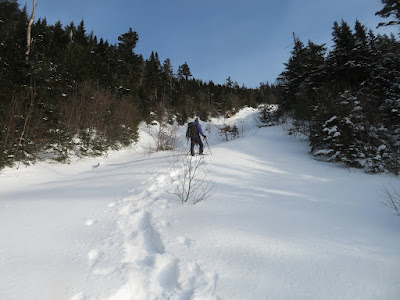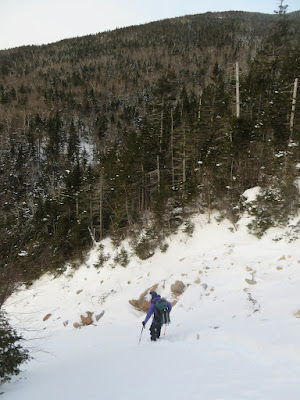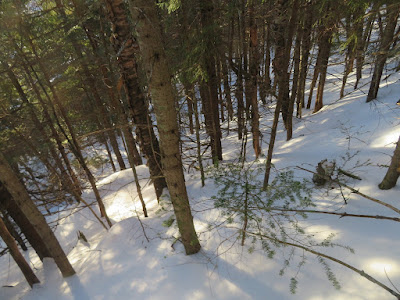On a cold, deep winter day I teamed up with Cath Goodwin for a snowshoe bushwhack to a slide on the west side of the Franconia Range, hidden in a valley between Little Haystack Mountain and Mt. Liberty. Perhaps the only locations this slide can readily be seen from are the summits of the Kinsmans; the view below is from North Kinsman. This is a fairly recent slide. My best guess is that it fell during the October 1995 storm that triggered the Dogleg Slide on Mt. Osceola and the big north slide on North Twin.
It was a -15 morning, but it had warmed to just above zero when we started up Falling Waters Trail around 10:00 am.
After crossing Dry Brook we headed into the woods for the long, slow bushwhack up and across the slope to the drainage of the slide. In the open hardwoods there was about two feet of soft, unconsolidated snow...
...making for a good old-fashioned day of trail-breaking.
In these woods were some wonderful old, gnarled trees, such as this yellow birch...
...and this sugar maple.
Looking back at our tracks, which would make the return trip much easier.
Farther along, the slope eased on a beautiful plateau of hardwoods.
Fallen giant.
We thought these might be bobcat tracks.
Open woods ahead.
My turn to break for a while, though Cath relishes trail-breaking and always does more than her share.
I had the idea that we might be able to use the drainage below the slide as a route, as for 0.4 mile below the base of the slide it looks wide open on Google Earth. But at that point the walls of the ravine are too steep to drop in. A study of the 2-foot contour Lidar map on the NH Granit website suggested that the first feasible entry point into the drainage is another quarter-mile downstream. As we approached this spot we could hear flowing water, and a glance down at the brook revealed several open pools; we would not be using the drainage as a route this day.
Instead, we headed up the slope on the north side of the drainage, through mostly open woods.
From the edge of the slope, we could see the now very steep dropoff into the drainage.
Some really nice woods on this route.
Birch and fir. We did hit a few conifer thickets along the way, but they didn't last long.
About 4 1/2 hours after our start, we approached the base of the two-pronged slide.
After a short, steep drop through dense conifers, we pushed through more scrub along the edge of the slide track.
In here, the snow was up to 3 1/2 feet deep.
This raised area of snow concealed a pile of woody debris at the base of the slide - careful snowshoe placement needed.
Cath pushing through more brush - slide revegetation is well underway here!
Kicking steps up a bank to gain the slide itself.
Here I plunged into the first spruce trap of the season.
Making tracks up the lower, low-angle part of the slide's north fork.
A picturesque winter scene.
First views back to the Kinsmans.
Zoomed.
There was an interesting mix of snow conditions on the steeper part of the north fork, which is mostly gravel and loose rock in summer. On the climber's left - the way we ascended - the snow was wind-scoured, thin and crusty, with rocks poking through. On the climber's right, the snow - presumably deposited by the wind - was several feet deep.
Cath approaches the prominent boulder on the wide part of the slide above the island of trees that divides the two forks.
In the center is a sharp spine of gravel and rock.
Looking up from the spine towards the top of the slide.
There's Moosilauke!
Sweet view of the Kinsmans, with Mt. Moosilauke behind on the left. The south fork of the slide drops steeply below.
Side view.
After a nice break, descending carefully along the crusty spine.
Descent with a view.
Heading back down the north fork, with a spur ridge of Little Haystack rising behind.
That was a good climb! Since the slide is between Little Haystack and Mt. Liberty, we thought we could call it the Hayberty Slide.
Our tracks, soon to be erased by a snowstorm.
Pushing through thick stuff to climb out of the drainage.
The golden hour.
Time to head down. The descent time along our tracks was less than half of the ascent time.














































































